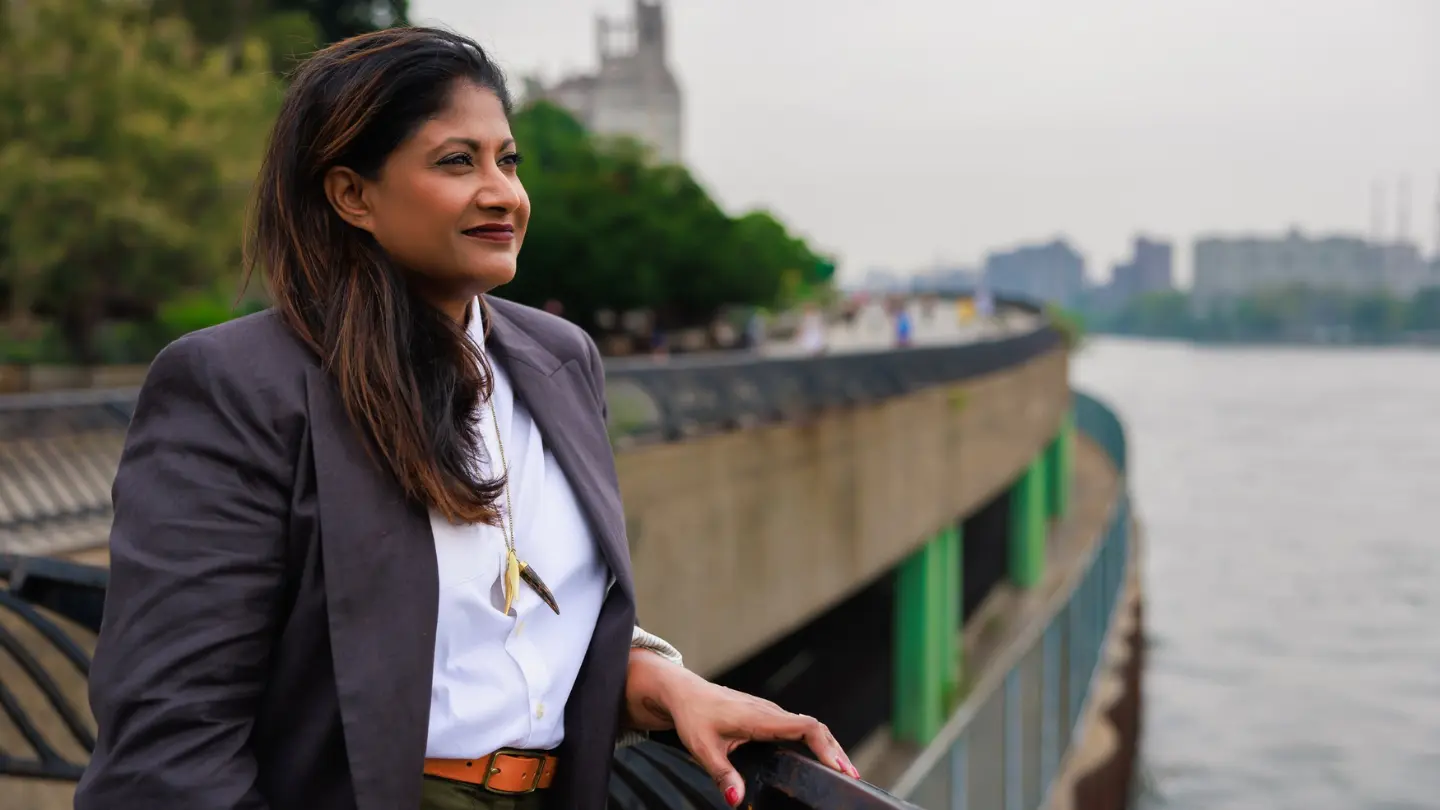Stories from the frontlines: Amali Tower on climate refugees and forced displacement

The climate crisis is undoubtedly interconnected with other humanitarian crises. Over 376 million people around the world have been forcibly displaced by floods, windstorms, earthquakes or droughts since 2008.
To shine a light on this subject, we interviewed Amali Tower, the CEO of Climate Refugees. With extensive knowledge and experience from her work at the UN Refugee Agency and the US Refugee Admissions Program, Amali is leading the way in ensuring that the stories of climate refugees are heard.
Her work has been used to inform governments and numerous UN reports, including case studies from the Lake Chad Basin and Kenya presented as evidence of loss and damage at COP26 and COP28. Her work interviewing communities impacted by climate change in Central America’s Dry Corridor region is forthcoming this year.
Why did you found Climate Refugees?
I founded the organization over 10 years ago because I heard refugees tell me their own stories and testimonies about climate collapse, environmental degradation and displacement. You ask every refugee these questions: ‘Why did you leave your country, and why can’t you return?’ I now recall how many said there was nothing to go back home to. Not only because of the effects of war, but also because even before they had fled their countries, rising temperatures, desertification and drought had been drying up their access to water and natural resources.
No doubt weapons and munitions were contributing to scorching their lands. They said the crops were just not growing like they had in the past. Mothers told me they couldn’t feed their children. They told me, even in their many decades away from home… in exile… they hear these same stories from the homeland. What was stark was hearing them share the totality of their loss: that it had been quite some time since they had been able to live the way they have for generations.
I realize now they were describing cultural loss as well. In this work, you get used to thinking and hearing that it was clearly because they had fled from a war. But many people also talk about how difficult life was, and still is, in many other ways that are not directly connected to war. I found out that it isn’t as simple as ‘life was great, and then there was the war, and now I’m displaced’. There are so many other issues that factor into peoples’ lives like loss of opportunities, education, jobs, livelihoods and dozens of everyday necessities every human needs. It’s in that context that I started to hear people describe climate change and its effects on populations on a more personal level, which was one of the driving factors in founding this organization, and remains my personal driving ethos for why I continue with this work.
How do you think the climate crisis relates to other humanitarian crises?
The most stark and urgent example I must mention today is Palestine. Besides the totality of the horrors we all know, see and witness, we now also know that Israel’s carbon emissions during 15 months of its genocide in Gaza, including the rebuilding to come, will top the carbon emissions of over 100 countries. Just think about that! We are already fighting for climate justice for the poorest and most vulnerable countries in the world who have zero to little carbon emissions, both historically and currently. There is no denying also that wars and militarism are leading to crisis upon crisis, including climate collapse.
I’ll give you another example. To really understand the lived experiences of these interconnected crises, I spoke to people around the Lake Chad Basin in Africa, documented in our report. This lake is shared amongst populations in Nigeria, Niger, Cameroon and Chad. In my many discussions with refugees and IDPs displaced by an ongoing war in this region between Boko Haram and multiple governments, one of the standout moments for me was their description of the attacks that have been happening since 2009. They told me ‘We wouldn’t have been attacked if the lake didn’t dry up’. You see, about 40 million people live in and around the lake basin, and the lake actually acted as a buffer zone between local populations and armed groups. But in recent times, temperature rise, low, variable or erratic rainfall, coupled with the higher rates of evaporation, has led to Lake Chad shrinking, and in some instances, that drying up and shrinking led to communities directly coming into the dangers of armed conflict.
Refugees and internally displaced people told me the lake drying cleared the way for Boko Haram to access their villages, both on foot and with their vehicles to attack the people there. These crises are far more interconnected than people think.
Why is the number of climate refugees increasing? Is this expected to continue to increase?
There are several reasons for the global increase in refugee numbers – including war and violence, persecution, climate change and its many interrelated factors. From a climate change perspective, a main cause are rising temperatures and the knock-on effects that those have on communities. We’re not just seeing an acceleration in the frequency of disasters and weather-related events, we’re also seeing an increased intensity too, well past what communities are prepared to deal with.
Many documented cases of climate-related displacement, even migration and mobility we know of, are of people moving internally within their countries. But given this type of displacement and forced movements are happening to vulnerable populations in Global South countries that are very much on the front lines of the climate crisis, it is a huge impact for these communities and countries to bear. And people aren’t necessarily moving into better situations.
People are on the move across borders too, and there too, we can surmise that it is mostly to neighboring countries in the Global South where climate effects are most extreme. People have spoken heartbreakingly to me about fighting for their right to stay in their homes, in their countries. We have to realise, for many, many people, this is forced movement. We’re seeing a lot of distress migration as well, where people may be on the move for economic reasons directly because of the climate impacts on livelihoods – and a lot of these people don’t even get a chance to enter, let alone have a chance to share why they migrated, what forces drove them from their homes.
In a lot of these situations, people get into debt in order to move for jobs that are often exploitative and/or bonded labor. So we also need to recognise the political economy of the climate crisis – how fossil fuel companies create climate change, and how everyday people are bearing its brunt in the day-to-day costly activities of life.
Are certain communities more affected by the climate crisis than others?
By far it is the poorest and most marginalised people in the world who are most affected. These populations are also mostly in the Global South, in developing countries who have had little to no contribution towards the climate crisis. They are also the people of color, immigrants, Indigenous communities in the Global North.
The need for climate justice exists in both poles. In short, those with the least contribution to climate change are paying the heaviest price – right now! Pastoralist, agricultural communities, people living in rural and under-developed regions where access to resources like water, arable land, irrigation, even roads and basic infrastructure, as well as poor and vulnerable people who are forced to migrate to cities, only to do menial labour, live in informal settlements and work in informal sectors, are really struggling.
What should governments do to tackle the problem of forced migration?
Well first of all, many governments lack understanding or are reluctant to better understand why people are on the move. They are also reluctant to lead with established processes that facilitate order and welcome, even asylum due process.
Instead they are spending a lot of money, time and rhetoric securitising their borders and othering migrants to drum up inhumane policy and discourse. It’s important to understand that there’s not one solution, and necessary policy outcomes differ greatly depending on which population we’re talking about. That being said, climate work can be woven into all justice work with just a little bit of effort in order to help combat climate-mobility and immobility.
It’s also important to note that a lot of the funding for these countries is being split into different sectors that aren’t necessarily helping fight the climate crisis. Development and humanitarian aid should be separate from climate finance. And even with dwindling numbers, a lot of that climate finance money is being used to keep the status quo, not actually help build the lasting infrastructure, resilience and adaptive solutions people need to ensure a right to stay or a right to migrate. It’s certainly not going towards the climate reparations people need as well.
Sustainability leaders such as Amali Tower are instrumental in the pursuit of environmental justice. Their efforts include fighting for justice for all, including those who are displaced by the climate crisis, ensuring that their voices are heard and that we take all steps necessary to help those being forced out of their homes, no matter the reason. You can find out more on Climate Refugees here.
Learn more about climate game changers and their key role in protecting the health of our environment in our blogs.
We recommend:
Stay up to date with climate news, subscribe to our newsletter: https://greenhouse.agency/greenhouse-morning-news/


